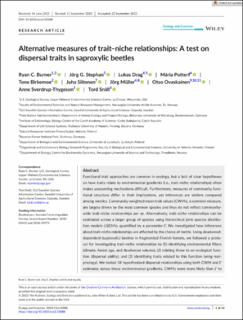| dc.description.abstract | Functional trait approaches are common in ecology, but a lack of clear hypotheses on how traits relate to environmental gradients (i.e., trait–niche relationships) often makes uncovering mechanisms difficult. Furthermore, measures of community functional structure differ in their implications, yet inferences are seldom compared among metrics. Community-weighted mean trait values (CWMs), a common measure, are largely driven by the most common species and thus do not reflect community-wide trait–niche relationships per se. Alternatively, trait–niche relationships can be estimated across a larger group of species using hierarchical joint species distribution models (JSDMs), quantified by a parameter Γ. We investigated how inferences about trait–niche relationships are affected by the choice of metric. Using deadwood-dependent (saproxylic) beetles in fragmented Finnish forests, we followed a protocol for investigating trait–niche relationships by (1) identifying environmental filters (climate, forest age, and deadwood volume), (2) relating these to an ecological function (dispersal ability), and (3) identifying traits related to this function (wing morphology). We tested 18 hypothesized dispersal relationships using both CWM and Γ estimates across these environmental gradients. CWMs were more likely than Γ to show support for trait–niche relationships. Up to 13% of species' realized niches were explained by dispersal traits, but the directions of effects were consistent with fewer than 11%–39% of our 18 trait–niche hypotheses (depending on the metric used). This highlights the difficulty in connecting morphological traits and ecological functions in insects, despite the clear conceptual link between landscape connectivity and flight-related traits. Caution is thus warranted in hypothesis development, particularly where apparent trait–function links are less clear. Inferences differ when CWMs versus Γ estimates are used, necessitating the choice of a metric that reflects study questions. CWMs help explain the effects of environmental gradients on community trait composition, whereas the effects of traits on species' niches are better estimated using hierarchical JSDMs. | en_US |

